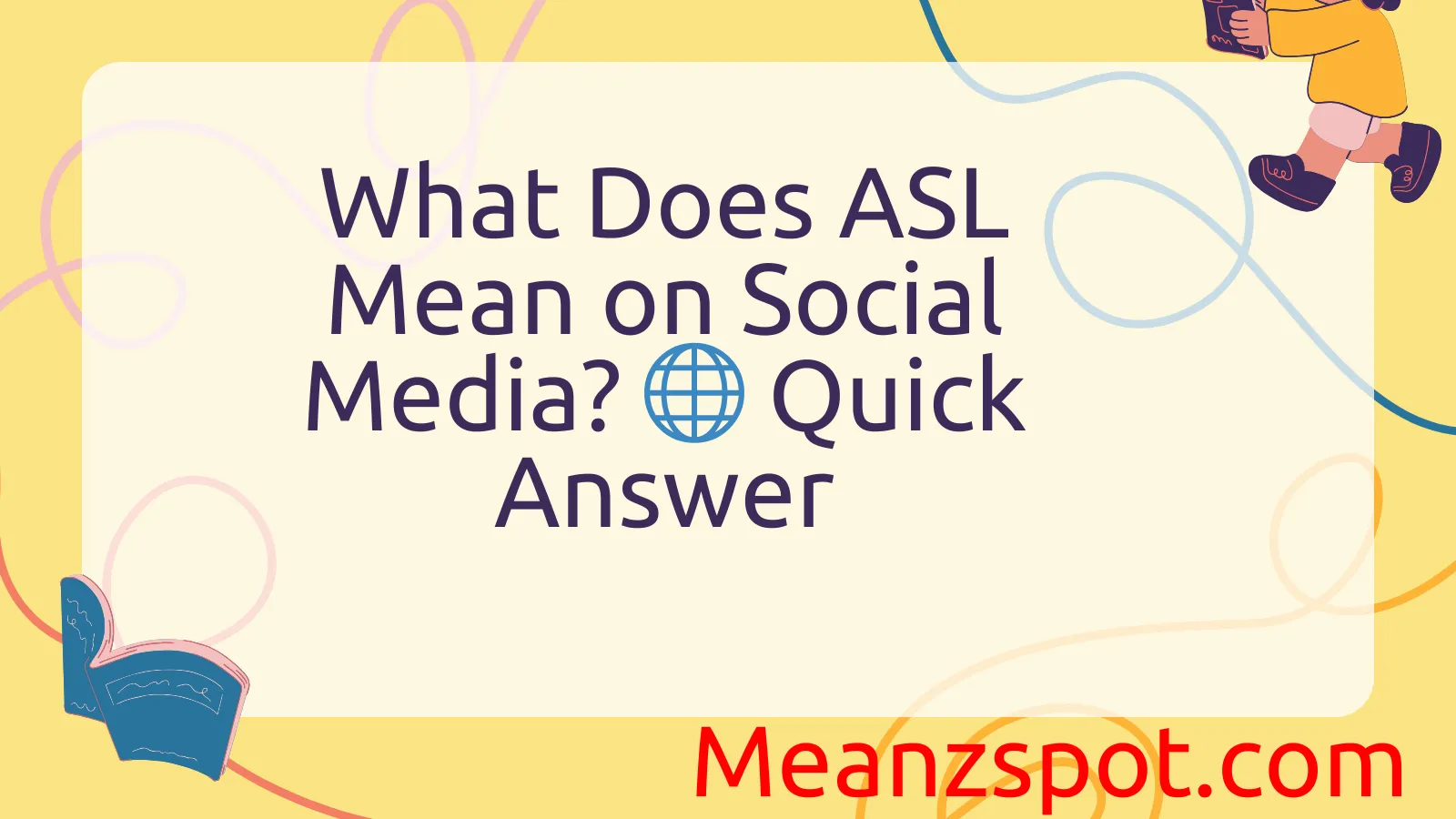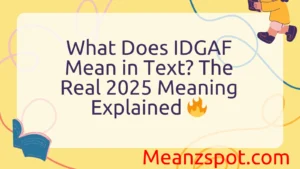In the age of digital communication, abbreviations and acronyms dominate our conversations. One such acronym you may encounter in online chats, social media, or text messages is “ASL.” For many, this three-letter term prompts curiosity or confusion, especially when it appears suddenly in a conversation. Understanding what “ASL” means in text is important—not just to keep up with internet slang, but also to avoid potential misunderstandings.
“ASL” can mean different things depending on the context. Most commonly, it stands for Age, Sex, Location, a phrase that gained popularity in early internet chat rooms as a quick way to get to know someone. However, “ASL” also stands for American Sign Language, which adds another layer of meaning and potential confusion
Definitions & Meaning
The abbreviation “ASL” has two widely recognized meanings in digital communication:
- Age, Sex, Location: This is the most common informal use of “ASL” in text messaging and online chatrooms. It’s often used as a quick icebreaker, especially in anonymous online conversations, to learn more about the other person.
- Example:
User A: “Hey, asl?”
User B: “22, F, NY”
- Example:
- American Sign Language: In more formal or educational contexts, ASL refers to American Sign Language, the visual language used by many members of the Deaf and partially deaf communities in the United States and parts of Canada.
- Example:
“I’m currently taking ASL classes at college.”
- Example:
It’s important to recognize that the interpretation of “ASL” heavily depends on context. If the setting is a dating app or chat forum, it likely means Age, Sex, Location. In contrast, in academic or accessibility-focused discussions, it almost certainly means American Sign Language.
Origins & History
The abbreviation “ASL” (Age, Sex, Location) gained prominence in the 1990s and early 2000s, during the early days of the internet. Chat rooms like AOL Instant Messenger (AIM), Yahoo! Chat, and IRC were popular, and users frequently used shorthand to communicate quickly. In these anonymous spaces, asking for someone’s age, sex, and location was a way to break the ice or determine compatibility, particularly in romantic or flirtatious conversations.
Simultaneously, ASL as American Sign Language has existed far longer. It originated in the early 19th century and was influenced by French Sign Language and local sign languages in the U.S. ASL is now a complete, complex language with its own grammar and syntax and is widely used in the Deaf community.
Interestingly, the overlap in abbreviation between these two meanings was initially unintentional, but as online culture grew, the dual meanings became more apparent. The rise of meme culture and internet slang has also kept “ASL” in circulation, often used jokingly or ironically today.
Usage in Different Contexts
Social Media & Chat Platforms
In informal settings such as TikTok, Snapchat, or text messaging, “ASL” often retains its original internet slang meaning. It might be used during casual conversations between strangers or within humorous content.
- Example:
“Some guy just slid into my DMs with ‘asl?’ What year is it—1999?”
Professional & Academic Settings
In more formal contexts, “ASL” typically refers to American Sign Language. In emails, academic articles, or workplace discussions, the term is usually associated with accessibility and inclusivity.
- Example:
“We are hiring an interpreter fluent in ASL for our company’s inclusion initiative.”
Pop Culture & Media
“ASL” has also made appearances in pop culture, both meanings included. Some TV shows or memes reference the chatroom slang nostalgically, while others focus on ASL in the context of Deaf culture, such as the film CODA, which brought mainstream attention to American Sign Language.
Education & Accessibility
In education, particularly in discussions about special education or linguistic studies, ASL refers exclusively to American Sign Language. It is offered as a course in many high schools and universities.
Understanding the context is key to interpreting what “ASL” means in any given conversation.
Common Misunderstandings & Clarifications
Given its dual meanings, “ASL” can easily lead to confusion. Here are a few common misunderstandings:
- Mistaking Internet Slang for Formal Language:
Someone may interpret “ASL” (age, sex, location) as inappropriate or outdated, especially in today’s more privacy-conscious internet culture. - Confusing Sign Language with Slang:
In conversations about accessibility, assuming ASL means “age, sex, location” instead of “American Sign Language” can come across as ignorant or dismissive. - Out-of-Context Usage:
Using “ASL” without context in professional emails or educational discussions can lead to misunderstandings. For example, saying “We need someone who knows ASL” might be misinterpreted by someone unfamiliar with American Sign Language. - Generational Gap:
Younger users might be unfamiliar with the “age, sex, location” meaning, having grown up in a different digital environment where the phrase is less commonly used.
Clarifying the context or spelling out the full phrase can help prevent these issues.
Alternatives & Synonyms
Depending on the intended meaning, there are several alternatives to “ASL”:
If used as “Age, Sex, Location”:
- “Stats?” – A modern, casual way to ask similar questions.
- “Basic info?” – A less invasive and more polite version.
- Full questions: “How old are you?”, “Where are you from?”, “Are you male or female?” (although more inclusive language is recommended today).
If used as “American Sign Language”:
- “Sign Language” – A broader term, although not always accurate (ASL is one of many sign languages).
- “ASL interpreter” / “ASL user” – Common professional references.
- “Deaf culture” – Sometimes used to describe the broader context involving ASL users.
As society becomes more inclusive, it’s also increasingly common to ask about pronouns or identity in more respectful and open-ended ways than “ASL?” ever allowed.
Frequently Asked Questions (FAQ)
1. What does ASL stand for in texting?
In texting, “ASL” usually means Age, Sex, Location—a quick way to ask for someone’s basic information.
2. What is ASL in education or accessibility contexts?
In those contexts, ASL stands for American Sign Language, a visual language used by the Deaf and partially deaf communities.
3. Is it appropriate to use “ASL?” in modern online conversations?
Not usually. It’s often seen as outdated or intrusive. Many prefer more respectful, open-ended ways of getting to know others.
4. Can ASL mean something else besides these two meanings?
In niche contexts, acronyms like ASL may stand for other things (e.g., Automated Speed Limiter in tech), but these are rare in casual communication.
5. How do I know which ASL meaning is intended?
Context is everything. If the topic is accessibility or education, it’s likely American Sign Language. If it’s a casual or flirty chat, it may mean Age, Sex, Location.
6. Is ASL still used in chatrooms today?
Yes, but mostly ironically or as a nostalgic reference. It’s far less common in modern apps like WhatsApp or Instagram.
7. How is ASL (American Sign Language) different from English?
ASL is a completely separate language with its own grammar and structure. It’s not just a signed version of English.
Conclusion
Understanding what “ASL” means in text depends largely on context. While it originally gained fame as an internet shorthand for “Age, Sex, Location,” it also has deep linguistic and cultural significance as “American Sign Language.” The potential for confusion is high, but so is the opportunity for learning.
Whether you’re navigating a conversation in a chatroom, discussing accessibility, or exploring Deaf culture, knowing the correct interpretation of “ASL” can enhance your communication and prevent misunderstandings. In our increasingly digital and diverse world, awareness of such abbreviations and their nuances helps promote both clarity and inclusivity.



